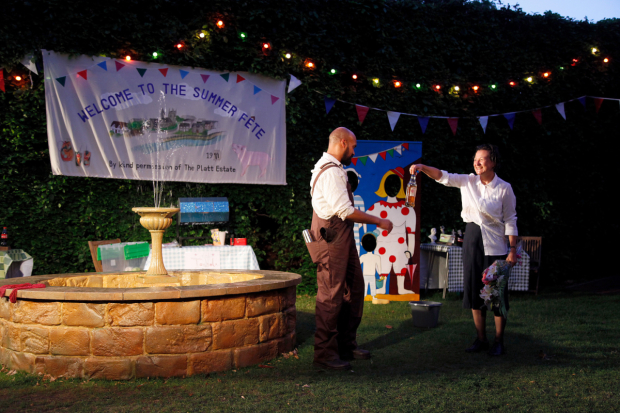A maypole, a fountain and a three metre hedge: the perils of designing Ayckbourn's House and Garden
Designer Neil Irish on creating the sets for the Watermill’s production of Alan Ayckbourn’s plays

© Philip Tull
Designing the productions of House and Garden for The Watermill became as much about logistics as aesthetics.
The two plays run concurrently and, because the same cast play in in each, quick access is required between each set. For Garden we wanted to use as much of The Watermill’s natural assets as possible. The script calls for bushes and shrubs to hide in, and areas for surprise entrances and exits. We didn't want to import prop foliage, or build structured masking to achieve these requirements. Acoustic issues had to be considered when finding the location. Large trees and shrubs in full leaf are very noisy in heavy winds as is a nearby river and weir.
We also needed a flat, well-drained area with enough space for two large, raked seating banks for 150 people. The space had to be large enough for a full-scale fete to be constructed during the performance and a large, deep, practical fountain, as well as a maypole with enough room for eight children to dance safely. We were lucky enough to find a space that was big enough to contain all these elements while still being intimate, focused and allow for the actors to be audible. It has a lovely three-metre high hedge backing it which allows safe entrances through it, and gives a clear, uniform natural backdrop.
Similar challenges concerning space had to be overcome for House. Most of the adult cast appear together and in one scene eight children gather upstage. The script calls for a large, period home, a lounge and larger rooms off this main space. The Watermill stage is very shallow and has a lot of sight line issues, especially from the balcony and upstairs slips.

© Philip Tull
We’ve tried to give an impression of a large lounge room with other practical rooms and wings coming off it, all of which have clearly visible doorways. The built elements of the set are integrated into the fabric of the auditorium. Beams and trusses are continued onto the set giving the illusion of a bigger, deeper integrated space. Colours and surfaces are sympathetic to the tones of the building. A large-scale, cut stone was chosen to help give the allusion of grandeur, scale and age.
The script tells us the room was once the library of the hall, but we were unable to explore this visually. All the doors in the set meant we had limited wall space and no space for alcoves or bookshelves. The minimal wall space also meant props and pictures mentioned in the text had limited areas for display. We needed to rationalise the entrances into this main space to a minimum and the placement of the doors was restricted to areas where actors could exit quickly and safely.
The stage directions also call for an entrance from the garden upstage, where a heavy shower of rain is seen. So, as well as an entrance upstage, space was needed for the mechanics to make this practical effect happen. A five-metre high printed cyclorama backed this entrance and was visible through the glass door and conservatory windows. This gave a great sense of depth when lit, when in reality, the cyclorama was only about six metres from the doorway.
A challenging design project then, creating space and free movement in small, restricted environments. Hats off to all at The Watermill who made it all work like clockwork!
By Neil Irish
House and Garden runs at The Watermill, Newbury until 1 July.













